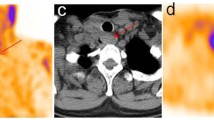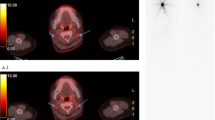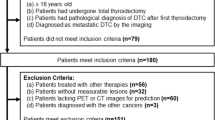Abstract
Objective
The aim of this study was to clarify the predictive significance of nodal calcification in terms of the therapeutic option of 131I therapy in papillary thyroid carcinoma (PTC) patients.
Methods
We reviewed 19 computed tomography (CT) examinations of PTC patients on receiving 131I therapy for the presence of nodal calcification, and compared the 131I whole-body scintigraphy and 18F-2-fluoro-2-deoxy-D-glucose (FDG) positron emission tomography (PET)/CT findings. The metastatic lymph nodes (mLNs) were divided into three groups: A, those with calcification; B, those without calcification but belonging to patients who had calcified mLNs; C, those without calcification and belonging to patients who had no calcified mLNs. The incidences of 131I accumulation and maximum standardised uptake values (SUV max) in the three groups were compared.
Results
A total of 70 mLNs were evaluated. Twelve mLNs belonged to group A, 13 to group B and 45 to group C. The incidences of 131I accumulation were significantly higher in groups A (100%) and B (100%) than in group C (11.1%) (p < 0.0001 for both). The SUVmax was significantly lower in groups A (4.1 ± 1.9) and B (3.9 ± 1.4) than in group C (7.1 ± 4.4) (p = 0.01, p = 0.002, respectively).
Conclusions
Our results indicated that calcification in mLNs related to the ability of 131I accumulation and less dedifferentiation.




Similar content being viewed by others
References
Lam AK, Lo CY, Lam KS (2005) Papillary carcinoma of thyroid: a 30-yr clinicopathological review of the histological variants. Endocr Pathol 16:323–330
Wang N, Xu Y, Ge C et al (2006) Association of sonographically detected calcification with thyroid carcinoma. Head Neck 28:1077–1083
Hoang JK, Lee WK, Lee M et al (2007) US Features of thyroid malignancy: pearls and pitfalls. Radiographics 27:847–860
Fish SA, Langer JE, Mandel SJ (2008) Sonographic imaging of thyroid nodules and cervical lymph nodes. Endocrinol Metab Clin N Am 37:401–417
Shetty SK, Maher MM, Hahn PF et al (2006) Significance of incidental thyroid lesions detected on CT: correlation among CT, sonography, and pathology. AJR Am J Roentgenol 187:1349–1356
Chan JK (1990) Papillary carcinoma of thyroid: classical and variants. Histol Histopathol 5:241–257
Machens A, Hinze R, Thomusch O et al (2002) Pattern of nodal metastasis for primary and reoperative thyroid cancer. World J Surg 26:22–28
Mirallié E, Sagan C, Hamy A et al (1999) Predictive factors for node involvement in papillary thyroid carcinoma. Univariate and multivariate analyses. Eur J Cancer 35:420–423
Wada N, Duh QY, Sugino K et al (2003) Lymph node metastasis from 259 papillary thyroid microcarcinomas: frequency, pattern of occurrence and recurrence, and optimal strategy for neck dissection. Ann Surg 237:399–407
Mittendorf EA, Wang X, Perrier ND et al (2007) Follow up of patients with papillary thyroid cancer: in search of the optimal algorithm. J Am Coll Surg 205:239–247
Ahuja AT, Chow L, Chick W et al (1995) Metastatic cervical nodes in papillary carcinoma of the thyroid: ultrasound and histological correlation. Clin Radiol 50:229–231
Rosário PW, de Faria S, Bicalho L et al (2005) Ultrasonographic differentiation between metastatic and benign lymph nodes in patients with papillary thyroid carcinoma. J Ultrasound Med 24:1385–1389
Langer JE, Mandel SJ (2008) Sonographic imaging of cervical lymph nodes in patients with thyroid cancer. Neuroimaging Clin N Am 18:479–489
Som PM, Brandwein M, Lidov M et al (1994) The varied presentations of papillary thyroid carcinoma cervical nodal disease: CT and MR findings. Am J Neuroradiol 15:1123–1128
Pacini F, Cetani F, Miccoli P et al (1994) Outcome of 309 patients with metastatic differentiated thyroid carcinoma treated with radioiodine. World J Surg 18:600–604
Woodrum DT, Gauger PG (2005) Role of 131I in the treatment of well differentiated thyroid cancer. J Surg Oncol 89:114–121
Feine U, Lietzenmayer R, Hanke JP et al (1996) Fluorine-18-FDG and iodine-131-iodide uptake in thyroid cancer. J Nucl Med 37:1468–1472
Wang W, Macapinlac H, Larson SM et al (1999) [18F]-2-fluoro-2-deoxy-D-glucose positron emission tomography localizes residual thyroid cancer in patients with negative diagnostic (131)I whole body scans and elevated serum thyroglobulin levels. J Clin Endocrinol Metab 84:2291–2302
Wang W, Larson SM, Tuttle RM et al (2001) Resistance of [18F]-fluorodeoxyglucose-avid metastatic thyroid cancer lesions to treatment with high-dose radioactive iodine. Thyroid 11:1169–1175
van den Brekel MW, Stel HV, Castelijns JA et al (1990) Cervical lymph node metastasis: assessment of radiologic criteria. Radiology 177:379–384
Khoo ML, Asa SL, Witterick IJ et al (2002) Thyroid calcification and its association with thyroid carcinoma. Head Neck 24:651–655
Merino MJ, Middleton LP (2001) Pathology of thyroid. In: Pilch BZ (ed) Head and neck surgical pathology. Lippincott and Williams & Wilkins, Philadelphia, pp 358–363
Ellison E, Lapuerta P, Martin SE (1998) Psammoma bodies in fine-needle aspirates of the thyroid: predictive value for papillary carcinoma. Cancer 84:169–175
Eisenkraft BL, Som PM (1999) The spectrum of benign and malignant etiologies of cervical node calcification. AJR Am J Roentgenol 172:1433–1437
Shammas A, Degirmenci B, Mountz JM et al (2007) 18F-FDG PET/CT in patients with suspected recurrent or metastatic well-differentiated thyroid cancer. J Nucl Med 48:221–226
Moog F, Linke R, Manthey N et al (2000) Influence of thyroid-stimulating hormone levels on uptake of FDG in recurrent and metastatic differentiated thyroid carcinoma. J Nucl Med 41:1989–1995
Chin BB, Patel P, Cohade C et al (2004) Recombinant human thyrotropin stimulation of fluoro-D-glucose positron emission tomography uptake in well-differentiated thyroid carcinoma. J Clin Endocrinol Metab 89:91–95
Ma C, Kuang A, Xie J, Ma T (2005) Possible explanations for patients with discordant findings of serum thyroglobulin and 131I whole-body scanning. J Nucl Med 46:1473–1480
Wang W, Larson SM, Fazzari M et al (2000) Prognostic value of [18F] fluorodeoxyglucose positron emission tomographic scanning in patients with thyroid cancer. J Clin Endocrinol Metab 85:1107–1113
Schoder H, Yeung HW (2004) Positron emission imaging of head and neck cancer, including thyroid carcinoma. Semin Nucl Med 34:180–197
Author information
Authors and Affiliations
Corresponding author
Rights and permissions
About this article
Cite this article
Kaneko, K., Abe, K., Baba, S. et al. Can calcification predict 131I accumulation on metastatic lymph nodes in papillary thyroid carcinoma patients receiving 131I therapy? Comparison of CT, 131I WBS and 18F-FDG PET/CT. Eur Radiol 20, 477–483 (2010). https://doi.org/10.1007/s00330-009-1557-5
Received:
Revised:
Accepted:
Published:
Issue Date:
DOI: https://doi.org/10.1007/s00330-009-1557-5




